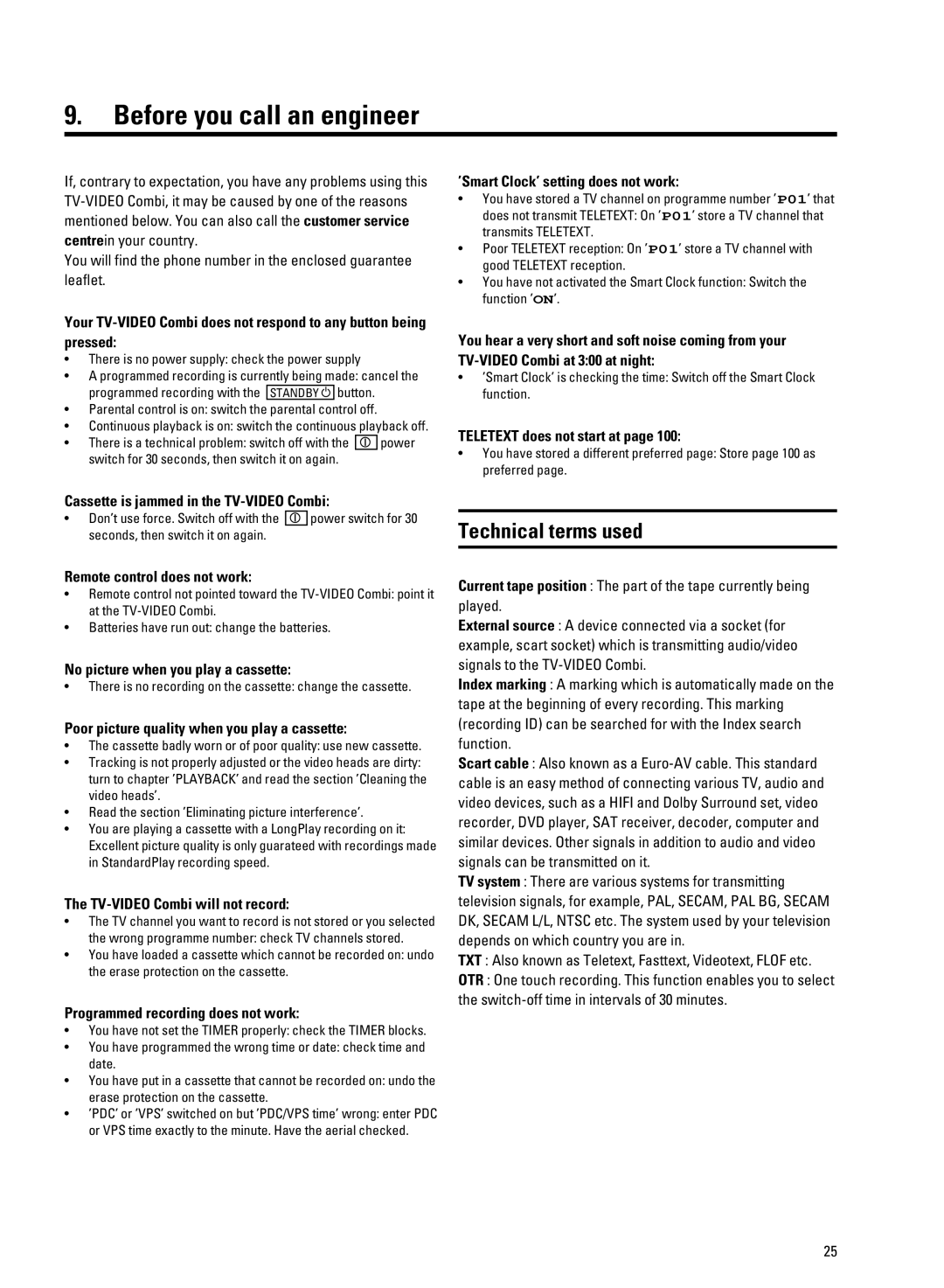
9.Before you call an engineer
If, contrary to expectation, you have any problems using this
You will find the phone number in the enclosed guarantee leaflet.
Your
•There is no power supply: check the power supply
•A programmed recording is currently being made: cancel the
programmed recording with the STANDBY m button.
•Parental control is on: switch the parental control off.
•Continuous playback is on: switch the continuous playback off.
• There is a technical problem: switch off with the 8 power switch for 30 seconds, then switch it on again.
’Smart Clock’ setting does not work:
•You have stored a TV channel on programme number ’P01’ that does not transmit TELETEXT: On ’P01’ store a TV channel that transmits TELETEXT.
•Poor TELETEXT reception: On ’P01’ store a TV channel with good TELETEXT reception.
•You have not activated the Smart Clock function: Switch the function ’ON’.
You hear a very short and soft noise coming from your
•’Smart Clock’ is checking the time: Switch off the Smart Clock function.
TELETEXT does not start at page 100:
•You have stored a different preferred page: Store page 100 as preferred page.
Cassette is jammed in the TV-VIDEO Combi:
• Don’t use force. Switch off with the 8 power switch for 30 seconds, then switch it on again.
Remote control does not work:
•Remote control not pointed toward the
•Batteries have run out: change the batteries.
No picture when you play a cassette:
•There is no recording on the cassette: change the cassette.
Poor picture quality when you play a cassette:
•The cassette badly worn or of poor quality: use new cassette.
•Tracking is not properly adjusted or the video heads are dirty: turn to chapter ’PLAYBACK’ and read the section ’Cleaning the video heads’.
•Read the section ’Eliminating picture interference’.
•You are playing a cassette with a LongPlay recording on it: Excellent picture quality is only guarateed with recordings made in StandardPlay recording speed.
The TV-VIDEO Combi will not record:
•The TV channel you want to record is not stored or you selected the wrong programme number: check TV channels stored.
•You have loaded a cassette which cannot be recorded on: undo the erase protection on the cassette.
Programmed recording does not work:
•You have not set the TIMER properly: check the TIMER blocks.
•You have programmed the wrong time or date: check time and date.
•You have put in a cassette that cannot be recorded on: undo the erase protection on the cassette.
•’PDC’ or ’VPS’ switched on but ’PDC/VPS time’ wrong: enter PDC or VPS time exactly to the minute. Have the aerial checked.
Technical terms used
Current tape position : The part of the tape currently being played.
External source : A device connected via a socket (for example, scart socket) which is transmitting audio/video signals to the
Index marking : A marking which is automatically made on the tape at the beginning of every recording. This marking (recording ID) can be searched for with the Index search function.
Scart cable : Also known as a
TV system : There are various systems for transmitting television signals, for example, PAL, SECAM, PAL BG, SECAM DK, SECAM L/L, NTSC etc. The system used by your television depends on which country you are in.
TXT : Also known as Teletext, Fasttext, Videotext, FLOF etc.
OTR : One touch recording. This function enables you to select the
25
